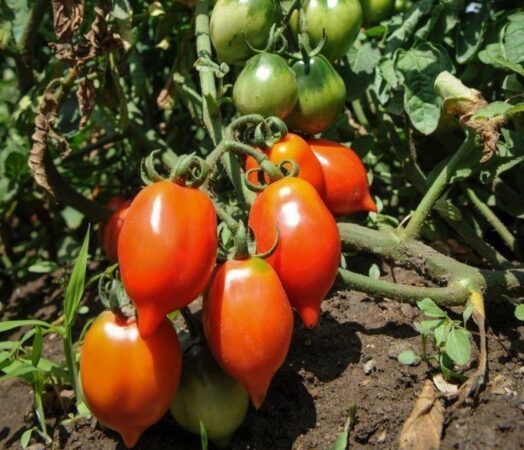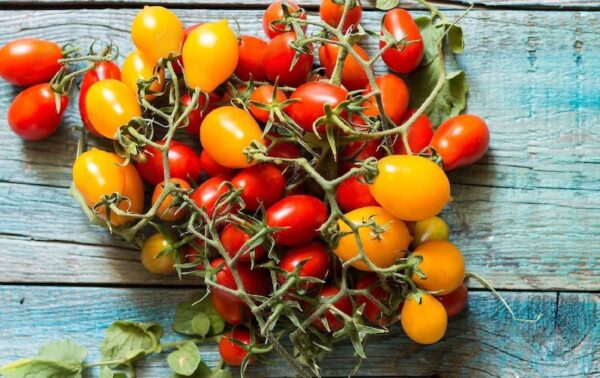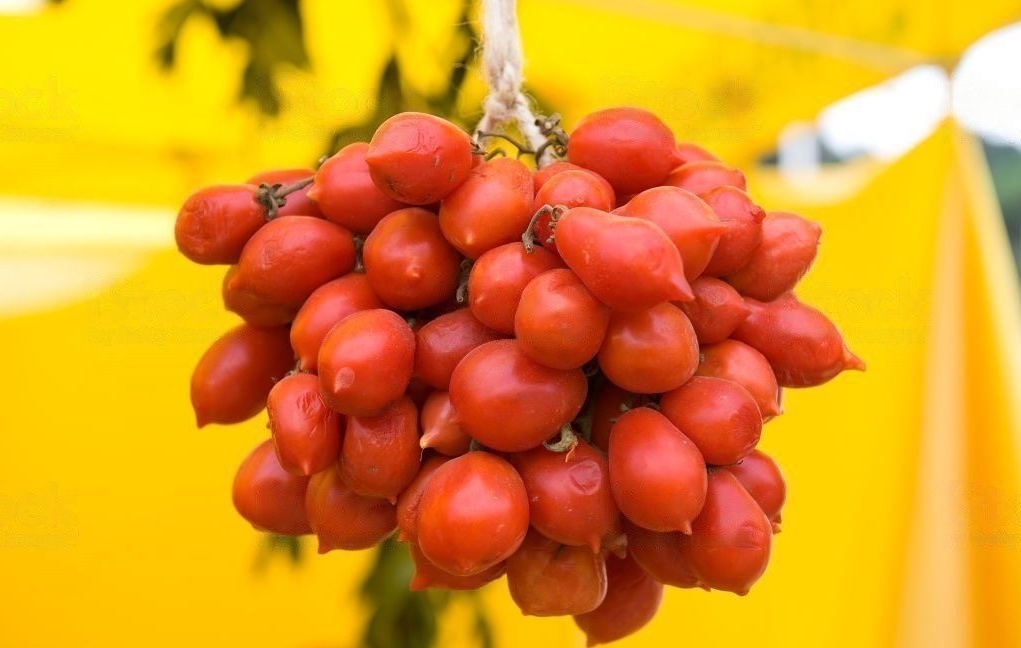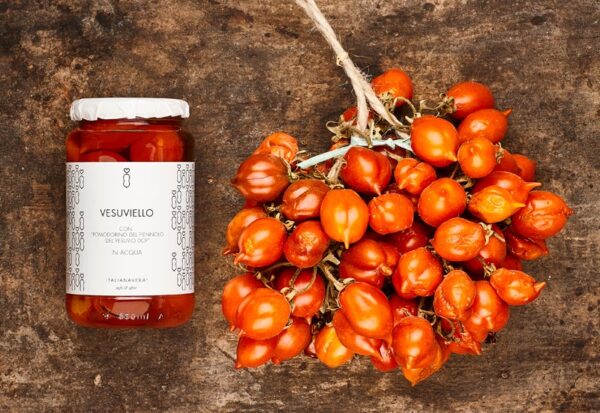We’re back again with the next installment of: Know Your Italian Tomatoes! Today we’ll be discussing everything you need to know about another delicious Italian tomato, the Piennolo – including what to cook with them and how to get your hands on them.
General Description
The piennolo tomato is yet another amazing tomato variety grown in the Campania region of Italy – specifically in the area immediately surrounding Mount Vesuvius. The full name of the variety is “Piennolo del Vesuvio” or “Pomodorino del Piennolo del Vesuvio” which is a mouthful. You’re going to want a mouthful of these tomatoes!
Origin
A very old variety of tomato, they’re so integral in the Neapolitan area that they even make their way into the local nativity scenes: 
Piennolo means “hanging” in the Neapolitan dialect, which is a very important clue as to why these tomatoes are so great. Due to the combination of high sugar and acid content, low water content, and an especially thick skin, these tomatoes stay good for a very long time after hanging.
If they’re hung up in a cool, airy place, they can stay good for months after harvest. The tomatoes are strung up on a hemp string in large clusters – maybe 100 tomatoes per string – and then these can easily be hung up. The slow drying/ripening process makes their flavor and aroma stronger over time.
Appearance
They’re often referred to as cherry tomatoes, but have more of a grape shape with two very distinctive features – a teardrop at the bottom and grooves along the side. They are typically bright red, but a yellow variety has also been bred.
Flavor
They’re very sweet and have a mineral characteristic to their flavor, much like another popular tomato from the region: the corbarino tomato. They’re also very intense, tangy, and sometimes a bit sour – and these characteristics are especially pronounced when hung up before eating them.
French Guy Cooking
Ok, now that you sat through my description I'm going to have to point you to this video - my favorite food youtuber (foodtuber?) Alex did a video on Piennolos. You should watch it. Maybe finish this article first? Maybe not - he's great and his video is great.Piennolo Nutrition
There isn’t a huge amount of variation in the nutritional profile of different types of tomatoes.
All tomatoes are famous for being high in lycopene – an antioxidant known to have positive effects on aging and inhibit certain types of cancer. Unless you’re on an acid-restricted diet tomatoes are great for you, and the piennolo is definitely included in that list.
Piennolo recipes
There are many, many dishes that piennolo tomatoes would be appropriate for. First and foremost are sauce and soup recipes, the complex intense flavor makes for an incredible sauce.
Did you know that there are official Napoletana pizza rules? (I wish they had those everywhere so that I wouldn’t have to see pineapple on pizza menus ever again.) These pizza rules include allowable varieties of tomatoes that can be used on pizzas. As you probably guessed, Piennolo del Vesuvios make the list along with the other tomatoes from the region – San Marzanos and Corbarinos. Interestingly, my research did not turn up any specific piennolo pizza sauce recipes on the internet. I guess folks using them don’t like to talk about it! Secret weapons are important. You will however find a million recipes calling for San Marzanos – you can just substitute Piennolos.
Another key category of recipe that these tomatoes excel at are seafood recipes. These tomatoes grow within spitting distance of the Mediterranean and it as if the fish know it. There’s a mineral attribute to the flavor of Campania tomatoes which blends exceptionally well with the flavor of the sea. If you’re cooking for the feast of the seven fishes, you’d be wise to include Piennolos for at least 1 of the 7.
Recipe roundup
Here are some links to recipes that would be great with Piennolo tomatoes…
- Bruschetta Trio
- Neapolitan pizza sauce
- Mezze Pennone with Seabass, Piennolo Tomatoes, and Gaeta Olives
- Pesto Trapenese
- Pasta with Piennolo Tomatoes and Colatura
- Fricasseed chicken with Piennolo Tomatoes and Taggiasca Olives
- Spaghetti with Piennolo Tomatoes and Burrata
Piennolo Substitutes
Let’s say you see this in a recipe but can’t figure out where to buy them – this is no problem. Honestly, you’re more likely to have the other problem – you have gotten your hands on some delicious piennolo tomatoes and you want to substitute them into a recipe that calls for another type of tomato. In either case, here are a handful of ideal substitutes:
- Corbarino – another small variety from Campania that has similar flavor attributes, is suitable for authentic Neapolitan pizza, and is amazing in sauces and soups. These are a bit smaller than Piennolos, are a bit sweeter, and have similar acidity
- Datterini – fairly similar to Corbarinos, but with less of the mineral/marine flavor and even more sweetness. These are also smaller, sweeter, and similarly acidic to Piennolos.
- Pachino – the Cherry and Grappolo Pachino varieties are pretty similar to to the Piennolo, especially the characteristics of having thick skin and strong flavor. The Cherry is smaller than the Piennolo and the Grappolo is approximately the same size.
- San Marzano – if the size of the tomato isn’t relevant (soups and sauces definitely fill the bill) then San Marzanos make a great replacement. Like the Corbarinos, they have the same general flavor profile as Piennolos, being grown in the volcanic soil and Mediterranean air found around Mount Vesuvius
- Cherry – It doesn’t matter where you are, you’ll be able to find a variety of cherry tomato in your local grocery store, and they’ll work as a substitute for/by Piennolos. They’re fairly similar in size, acidity, and sweetness to Piennolos, and they’ll likely have a bit more water content.
- Grape – These aren’t a great replacement, but they’ll do in a pinch if you need small tomatoes with low water content. They’re generally fairly bland tomatoes (at least those you’d likely pick up at the grocery store) so I’d only use these as a last resort.
Where to Buy Piennolo Tomatoes
Fresh
Your best bet at getting your hands on some Piennolo tomatoes will probably be to find them at a farmers’ market. As an heirloom variety, you’re unlikely to find these at your local grocery store so hopefully the local farmers in your area like growing a wide array of varieties.
Even if you don’t see any for sale, it wouldn’t hurt to ask folks selling heirloom tomatoes if they are familiar with them and if they know anyone that may have them. One thing you’ve highly unlikely to see unless you’re in Italy is a huge cluster of them strung up and hanging from a hook.
If you don’t have a great farmers’ market nearby, your next best bet would be to go to your favorite Italian restaurant and ask the chef. They’re likely to have a connection for less common Italian ingredients and may be able to hook you up.
If you happen to have an Italian deli that has a ton of imported goods, there’s a chance they could have some. This would not be likely for any D.O.P produce, but due to the unique characteristic of these tomatoes that they can be hung up and stay good for months in the right conditions – they could actually be shipped around the world without going bad.
It’s fairly likely though that you’re just not going to be able to find them fresh! The best bet may be to grow your own (more on that below)

Canned
I searched high and low but I had no luck at any of my local Italian delis, you may have better luck. Fortunately, there are a handful of online sellers of these tomatoes.
How to grow Piennolo tomatoes
If you live in a climate that can grow tomato plants, I’d highly recommend growing your own. It’s a labor of love, but nothing tastes better than eating a tomato that you grew yourself in your garden.
Starting Seeds
Sowing tomatoes directly in the ground is not at all advisable. Start the seeds in starter pots with starter soil, 1/4″ deep in moist but not damp soil. At 2″ tall you’ll probably want to transplant them into 4″ pots. This should help to avoid the seedlings getting root bound before transplanting.
The seeds don’t like cold soil. If you’re not starting the seedlings in a heated building a heating pad can really help. Make sure the soil temps are between 70-90°F.
After spotting the first set of true leaves, be sure to fertilize regularly. Use 1/2 strength organic fertilizer until transplanting.
Transplanting
They’ll be safe to transplant when the overnight low temp doesn’t drop below 55°F. If everything is timed perfectly, the seedlings should be about 7-8 weeks old, or 5-6″ tall.
Plant them deeply in the soil – you can bury the bottom 2/3rds of the plant in the soil. Tomato plants are really cool, the little white “hairs” on the stem are called trichomes and will become roots if they detect they’re buried.
Staking or wire cages should be set up when first transplanted – this will help the plants stay off the ground when the tomatoes grow heavy.
Growing
Pick a spot with full sun exposure. The more sun, the better. Plants should be planted about 2 to 3 feet apart.
The soil should ideally be amended with aged manure or compost if available, or granular organic fertilizer if not. You’ll want to continuously provide fertilizer as they grow.
Surround the plants with lots of mulch to help retain moisture in the soil and prevent overheating in hot climates. These plants are generally pretty tolerant of heat, but production can drop if they overheat. You might need to set up a sunshade if the daytime temperature breaks 100 regularly.
Piennolo del Vesuvio are indeterminant plants, meaning they will continue to grow and produce as long as the conditions (temperature, sunlight, water, nutrients) allow.

Harvesting
As soon as a tomato turns fully red and has a little give to it when you squeeze it (gently!) then that thing is ripe. This should most likely take around 65-70 days. If you’re after tomatoes you can eat right away, you can go ahead and eat them as-is.
If you’re interested in following the traditional harvesting technique you’ll have fresh-ish tomatoes throughout the fall and into the winter. Make sure to harvest the tomatoes before they are ripe – perhaps at 70% ripeness. Tie dozens of clusters together on a hemp line, and hang them up somewhere cool, dry, and airy. This will allow them to ripen slowly and reach their maximum flavor potential.

Where to Buy Piennolo Del Vesuvio Tomato Seeds?
Piennolo seeds are really easy to find online. Here are a few places you can buy seeds online if your local nursery doesn’t carry them…



 only)
only)
